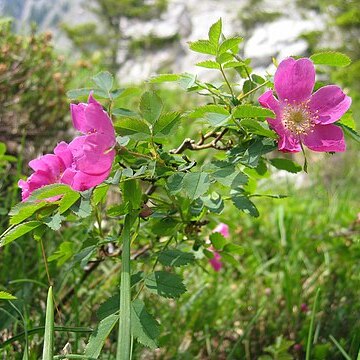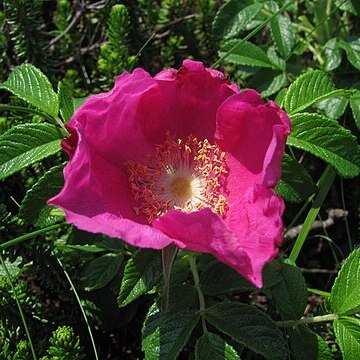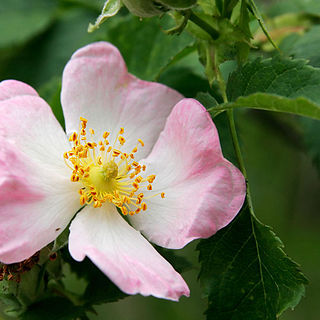Perennial, usually deciduous shrubs, sometimes scrambling or lianoid; stems armed with epidermal prickles, acicles, bristles, or simple or glandular hairs (sometimes intergrading), rarely not armed. Lvs distributed along stems, usually imparipinnate, sometimes basal pair reduced to 1 leaflet, very rarely simple or reduced to connate leaflike stipules; leaflets serrate or crenate; stipules usually adnate to petiole with distal free auricles, sometimes free to base and deciduous, variously lobed or with marginal stalked glands. Fls usually borne on lateral shoots 1 or more years old, in corymbs, panicles or solitary, usually bracteate, usually > 3 cm diam., large and showy, ☿ except in some semi-or fully double cvs, pedicellate, (4)-5-merous. Epicalyx 0. Hypanthium extremely variable, narrowly ovoid, narrowly urceolate, to globose, ± closed at apex by a disc; sepals all similar or outer 3 toothed or pinnately lobed and inner 2 entire. Petals 5, numerous in double-flowered cvs, those of single fls ± spreading, white, yellow, pink, red, purple, greenish or multicoloured, but not blue. Stamens numerous, fertile or petaloid. Ovary superior although carpels deeply sunken in the concave receptacle; carpels free, numerous; styles numerous, free or sometimes forming a short column protruding through the centre of the hypanthial disc; ovules 1 per carpel. Fr. an urceolate to globular or ovoid hip with many bony achenes included within the ± fleshy, coloured, sometimes prickly or bristly hypanthium.
Erect, climbing, or prostrate shrubs, nearly always armed with straight or curved prickles, often with glands. Leaves imparipinnate, leaflets pinninerved, usually serrate. Stipules adnate (rarely, not in Malesia: leaves unifoliolate without stipules). Flowers solitary and terminal or in terminal thyrses or racemes, large and showy, bisexual, nearly always 5-merous, cultivars often double. Hypanthium usually globular to urceolate, throat almost closed by a thickened annular disc. Sepals imbricate, often foliaceous and at least the outer ones often pinnately incised, persistent or caducous. Petals imbricate, different shades of red, white, or yellow. Stamens many. Pistils many, rarely few; ovaries superior, shortly stalked or subsessile, free, included in the hypanthium, 1-locular; styles terminal or lateral, free or with their upper parts coherent to connate, protruding through the hole in the disc; ovule 1, rarely 2, pendulous. Fruits achenes with usually bony pericarp, included in tbe accrescent, ± fleshy, coloured hypanthium (hip). Seed with thin testa; endosperm absent.
Shrubs, erect, diffuse, or climbing, mostly prickly, bristly, or rarely unarmed, pubescent, glandular-pubescent, or glabrous. Leaves alternate, odd pinnate, rarely simple; stipules adnate or inserted at petiole, rarely absent. Flowers solitary or in a corymb, rarely in a compound corymb or a panicle; bracts solitary, several, or absent. Hypanthium globose, urceolate, or cupular, constricted at neck. Sepals 5, rarely 4, quincuncial: 2 outer, 2 inner, and 1 middle, margin entire or variously pinnately lobed. Petals 5, rarely 4, imbricate, white, yellow, pink, or red; disc inserted at mouth of hypanthium. Stamens numerous, in several whorls, inserted at disc. Carpels free, numerous, rarely few, inserted at margin or base of hypanthium, not or rarely stalked; ovule pendulous; styles terminal or lateral, exserted or not, free or connate at upper part. Fruit a hip, formed from fleshy hypanthium. Achenes numerous, rarely few, on adaxial surface of fleshy hypanthium, woody. Seed pendulous. x = 7.
Hypanthium globose to urceolate, with a constricted orifice; sep usually long-attenuate or prolonged into a foliaceous tip, often persistent in fr; pet large, spreading at anthesis, pink to red, white, or yellow; stamens very numerous, inserted near the orifice of the hypanthium on relatively short filaments; ovaries mostly numerous, inserted on the bottom or also on the sides of the hypanthium; styles usually barely exserted, distinct or ± united; fr a bony achene; mature hypanthium, called a hip, commonly colored and pulpy or fleshy; shrubs or woody vines, usually prickly; lvs pinnately compound with 3–11 serrate lfls, the stipules commonly large and adnate to the petiole; x=7. Genus beset with hybridization and polyploidy. 100+, mainly N. Temp. The application of the names R. spinosissima and R. cinnamomea is now so confused that both have been abandoned in Flora Europaea. We do likewise.



